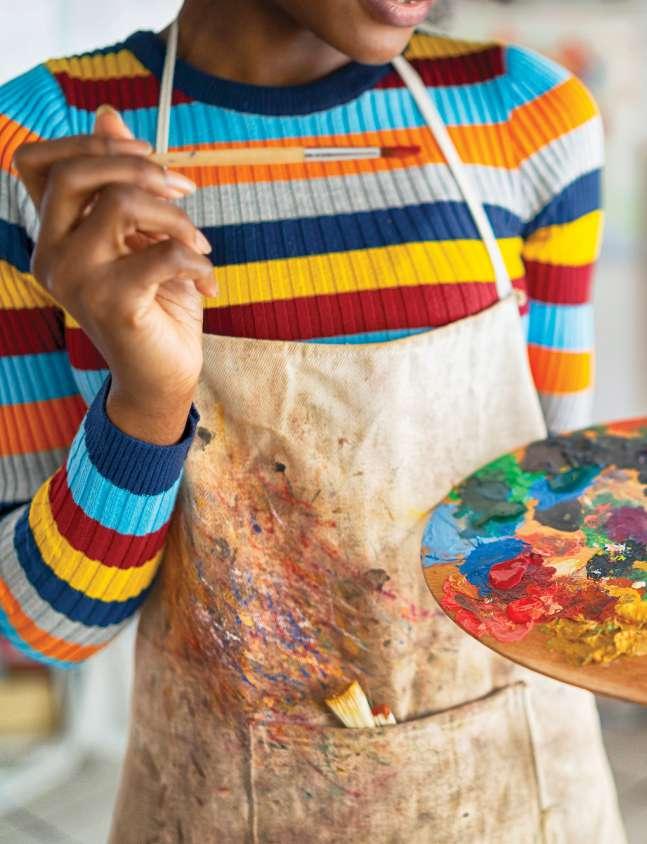
4 minute read
ART FOR ALL
It’s no longer just something you give to kids in restaurants to keep them entertained. Nope, artistic expression is helping adults too. We ask a mental-health expert to paint a picture of all the ways in which it can beneft you
TEXT: ANDREA ROBERTSON
Advertisement
Do you ever feel like just throwing buckets of paint onto blank white walls, in the hope that it could help you let off some steam after a long, frustrating week? Good. This feeling is totally valid (and you should go for it some time!)
People have been expressing their feelings through art for centuries, and art therapy as a formal practice has been around since the 1940s. It involves the use of any and all artistic mediums, such as drawing, colouring in, collage, painting and sculpture, to help diagnose and treat clients by examining the psychological undertones – the underlying messages or deeper issues –that are revealed in their art.
Art therapist Samantha Davis explains: “It is difficult to express oneself solely through words. Art offers an alternate way to express, explore and work through thoughts, feelings and concerns.”
Art Direction
Samantha has been practising art therapy for 20 years. We asked her to break down what art therapy is and how it can help you.
1Art therapy is a safe, contained and supportive space in which different art materials (such as paint, clay, chalk, charcoal, crayons, markers, objects to cut and paste, and so on) can be used to express and explore one’s thoughts and feelings. For many people, it is often easier to talk to a therapist through their artwork, which provides a focus for discussion, exploration and reflection. The therapist and client then work together in trying to understand the client’s personal process and creative expression in the session. Art therapy can be a very powerful experience that may enable long-buried feelings to come to the surface and be acknowledged. follow this up with a discussion on their artwork and reflect on their process.
2Words engage the left brain of rational thinking, structure and control. The medium of art engages the right brain of creativity and spontaneity. Hence the actual engagement of art becomes more of an ‘embodied’ experience – using the body to help shift difficult feelings that are not otherwise accessible through words only.
3
Art therapists use one of two methods of treatment. In directive work, they will suggest a theme, topic, structure or medium to inspire creativity (for example, draw your family or make something out of clay), and then those artworks are examined. The non-directive method, on the other hand, focuses more on building a relationship between therapist and client as a foundation; then, when the client is ready to explore certain areas of their lives, they do so at their own pace.
5People often think that there needs to be a specific problem or issue in order to ‘need’ art therapy. Or that art therapy works only for specific types of people, such as those who have a natural talent for art. But it is suited to everyone and anyone of all ages. Samantha has worked with a diverse range of people, including adults who struggle with stress, burnout, addiction, anxiety and depression, or who are wanting a life change, to find purpose or develop better coping and life skills. She has also worked with children with ADHD, anxiety, depression and learning difficulties, those with emotional or behavioural problems, autism or physical disabilities, kids who have suffered trauma or are living with HIV/Aids, as well as refugees, orphans and underprivileged children. She has also helped teens struggling with eating disorders.
Try It At Home
that jump out at you. Stick them down on a piece of paper in any design you like and see what you come up with. Don’t attempt to create a specific message or ‘decipher’ what you’ve done. Rather pinpoint the feelings that the image evokes in you and why.
• Get rid of pent-up stress by splashing paint onto a blank canvas. Use a paintbrush, your hands, your body – whatever you feel in the moment.
The Bonus
Various studies on the effectiveness of art therapy have found that it has many benefts, including as a supplementary treatment for those who are suffering from other health issues.
> It helps to reduce pain, decrease symptoms of stress and improve quality of life of those suffering from cancer.
> It improves the ability to deal with pain and other symptoms related to chronic disease.
4
Each treatment session and client is different but the average session lasts an hour and ideally occurs once a week to build trust, consistency and continuity. For non-directive sessions, there is a verbal check-in to see where the client is at, and from there it moves into a space in which they decide what they would like to create in that session with the materials available. When they are ready to talk, the therapist will then
The process of creating is what’s important here. Don’t focus on the final product or your level of artistic skill.
• Sketch in the dark or with your eyes closed for 30 minutes or more. Tape a piece of paper to a table and just let any shape or form come through your crayon or pencil. This will help you let go of any judgement of what you’re creating and allow your thoughts to spill out.
• Flip through old magazines and tear out images and words
> It reduces stress and anxiety in children who have asthma.
> It stimulates mental function in older adults with dementia.
> It’s able to stave off cognitive decline.
> It reduces depression in Parkinson’s patients.
> It promotes relaxation and reduces stress in hospital patients or people who are bed-bound due to illness.








